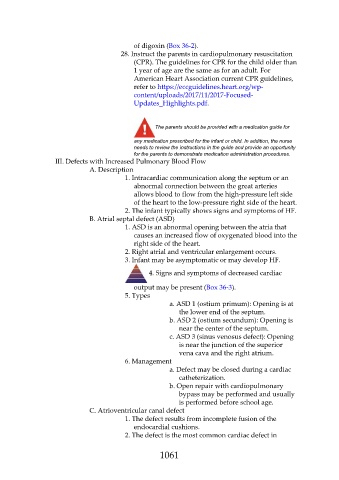Page 1061 - Saunders Comprehensive Review For NCLEX-RN
P. 1061
of digoxin (Box 36-2).
28. Instruct the parents in cardiopulmonary resuscitation
(CPR). The guidelines for CPR for the child older than
1 year of age are the same as for an adult. For
American Heart Association current CPR guidelines,
refer to https://eccguidelines.heart.org/wp-
content/uploads/2017/11/2017-Focused-
Updates_Highlights.pdf.
The parents should be provided with a medication guide for
any medication prescribed for the infant or child. In addition, the nurse
needs to review the instructions in the guide and provide an opportunity
for the parents to demonstrate medication administration procedures.
III. Defects with Increased Pulmonary Blood Flow
A. Description
1. Intracardiac communication along the septum or an
abnormal connection between the great arteries
allows blood to flow from the high-pressure left side
of the heart to the low-pressure right side of the heart.
2. The infant typically shows signs and symptoms of HF.
B. Atrial septal defect (ASD)
1. ASD is an abnormal opening between the atria that
causes an increased flow of oxygenated blood into the
right side of the heart.
2. Right atrial and ventricular enlargement occurs.
3. Infant may be asymptomatic or may develop HF.
4. Signs and symptoms of decreased cardiac
output may be present (Box 36-3).
5. Types
a. ASD 1 (ostium primum): Opening is at
the lower end of the septum.
b. ASD 2 (ostium secundum): Opening is
near the center of the septum.
c. ASD 3 (sinus venosus defect): Opening
is near the junction of the superior
vena cava and the right atrium.
6. Management
a. Defect may be closed during a cardiac
catheterization.
b. Open repair with cardiopulmonary
bypass may be performed and usually
is performed before school age.
C. Atrioventricular canal defect
1. The defect results from incomplete fusion of the
endocardial cushions.
2. The defect is the most common cardiac defect in
1061

